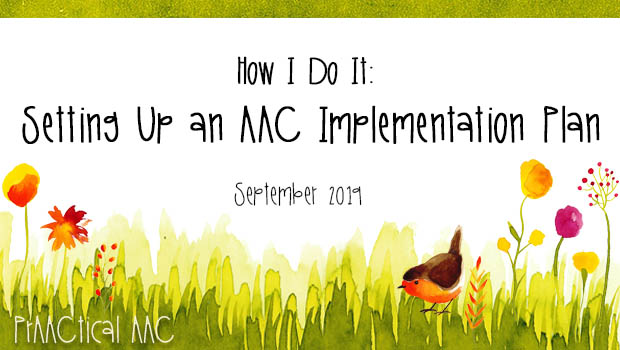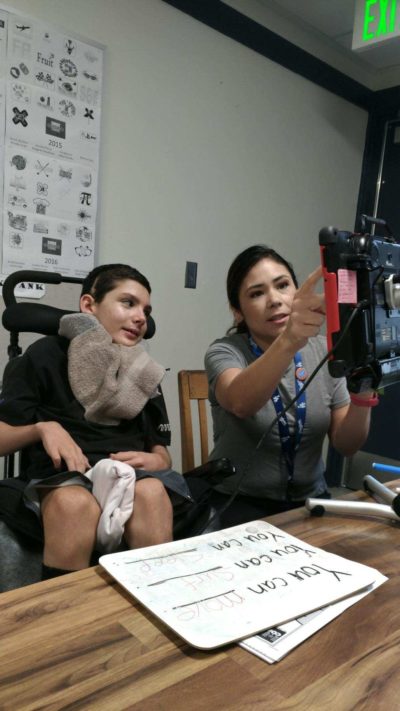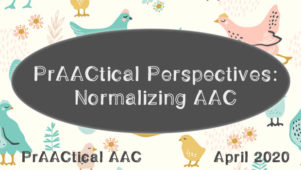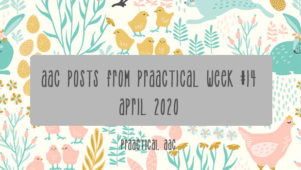How I Do It: Setting Up an AAC Implementation Plan

 Today we have a visit from California-based SLP Kristen Powell who is stopping by to share some of the ways she builds collaboration and sets up AAC implementation plans. Kristen works both in the public school system and runs her own private practice, Creative Communication. She specializes in assessment, device trials, and implementation training of AT and AAC. Kristen is passionate about providing individuals with the most appropriate AT and supports to improve their communication with their family and peers.
Today we have a visit from California-based SLP Kristen Powell who is stopping by to share some of the ways she builds collaboration and sets up AAC implementation plans. Kristen works both in the public school system and runs her own private practice, Creative Communication. She specializes in assessment, device trials, and implementation training of AT and AAC. Kristen is passionate about providing individuals with the most appropriate AT and supports to improve their communication with their family and peers.
::::::::::::::::::::::::::::::::::::::::::::::::::::::::::::::::::::::::::::::::::::::::::::::::::::::::::
In 2016, I got a job as a speech-language pathologist at a local school district. One of my students had multiple service providers both school and medical based. In addition, my student used both high and low tech Augmentative and Alternative Communication (AAC). I was faced with the challenge of helping the entire team know how to use the AAC system with the student, know what successful communication looks like for the student, and how does the student communicate when using different types of AAC. It was a true ‘deer in the headlights’ moment. Soon after, I watched a webinar from the Center on Technology and Disability Institute on AAC implementation plans by Laura Kessel M.S., CCC-SLP, ATP. This was exactly what I needed to implement the AAC system. I drafted an AAC implementation plan and reviewed it with the IEP team members. It was important for the IEP team members to have the opportunity to ask questions. Once it was accepted, each team member received a copy of the plan. It was also attached to my students IEP for easy access to any potential new IEP team members. The members of the IEP team were so grateful for a document that explained how the AAC system works and how it should be implemented. This blog post will discuss what an AAC implementation is and how you can develop one on your own.

Getting Started
- Develop a plan: You can designate someone to make the template. In my case, it was easier for me to develop the plan but it may be the special education teacher or other Individual Education Plan (IEP) team members. You’ll want to discuss roles and responsibilities prior to drafting one so that everyone on the IEP team is aware of their responsibilities. This includes parents. You will also want to discuss potential communication goals in each environment the AAC user is in.
- Define what success looks like: This is dependent upon where the AAC user is (emergent, context-dependent, independent). Example: The AAC system and strategies will be considered effective if the AAC user demonstrates:
- Increased vocabulary use
- Use with various communication partners
- Use in all communication environments
- Increased self-advocacy
- Troubleshooting: Define what red flags looks like for the AAC user. This is where the IEP would list problematic behaviors. Team will need to reassess how the AAC is being presented. If you’re setting the AAC implementation plan up for a trial, you’re red flag would be if the AAC user is not doing better with the AAC than without the AAC. In my case, we were not using the AAC implementation plan for a trial so red flags included:
- Difficulty with access
- Not responding to questions/comments from communication partners
- Communication Systems: List all the ways the AAC user communicates. You can include how to set up accessories in this section if there is a substitute they would know how to set up for AAC user to access. Our AAC users who use no-tech AAC (e.g., facial expressions, body language) this is where you would list what those are and what they look like.
- Strategies: List strategies used with the AAC user and which team member is responsible for using those strategies with the AAC user. Least-to-Most prompting hierarchy-use with vocabulary AAC user has demonstrated increased independence. Most-to-Least prompting-when introducing new vocabulary, Descriptive Teaching, Core and Fringe vocabulary, motor planning.
- Strategy example
| Strategy | When to Use | Team Member(s) Responsible |
| Descriptive Teaching | during academic instruction | Special education teacher, SLP |
| Aided Language Stimulation | throughout the day | teacher, SLP, aide, parents |
- Aided Language Stimulation-Activity Based Targets: Describe communicative functions, types of AAC being used during activity, communicative expectations, communication partners roles. You want to pick activities that are frequent and motivating for the AAC user. You may need to include icon sequence for the communication partner and insert it here.
| Activity | Function | AAC in use | Expectations | Communication Partner(s) & Role |
| Morning Circle | Greeting
Ask/Answer questions |
IPAD with TouchChat Wordpower | Say “good morning” to peer or adult
Ask or answer open-ended question |
Teacher and/or aides use least to most prompting
Aided language stimulation is provided by teacher and/or aides |
- Team Responsibilities
| Team Member Responsibilities | Teacher | AAC Specialist/SLP | Aide | OT | PT | Family | Other |
| Maintaining the AAC system | |||||||
| Charge the device | |||||||
| Troubleshoot problems | |||||||
| Contact tech support when needed | |||||||
| Back-up device | |||||||
| Provide a backup system if device is not available | |||||||
| Programming the AAC device | |||||||
| Identify new messages to be added | |||||||
| Program the device | |||||||
Having an AAC implementation plan gets the IEP team on the same page so that any service provider or staff member can pick up the plan, read it, and implement it. With the IEP team all implementing AAC the student is successful in communicating with others and making progress towards communication autonomy which is the ultimate goal. The AAC Implementation Plan should be updated at least once a year, typically during the IEP meeting. I don’t have an AAC Implementation Plan for every student. I do make one for students who have multiple service providers and use various types of AAC.
- AAC Implementation Plan Template
- Data Collection on Strategy implementation: Aided Language Stimulation. Now that the AAC implementation plan is developed you need to take data on whether or not the plan is working and your student is making progress. Below is an example from Gail Van Tatenhove’s The Student Augmentative and Alternative Communication Profile & Portfolio.
Direct Link to Document: http://www.vantatenhove.com/files/papers/DataCollection/StudentAACProfilePortfolio.pdf
Resources
Kessel: CTD AAC Implementation Presentation
Sennott, Light, McNaughton 2016: AAC modeling intervention research review. Research and Practice for Persons with Severe Disabilities.
Binger & Light, 2007: https://pennstate.pure.elsevier.com/en/publications/the-effect-of-aided-aac-modeling-on-the-expression-of-multi-symbo
:::::::::::::::::::::::::::::::::::::::::::::::::::::::::::::::::::::::::::::::::::::::::::::
About the Guest Author: Kristen is an ASHA-certified speech-language pathologist for a small school district in southern California where she also runs her own private practice, Creative Communication. She received her master’s degree from Northern Arizona University in 2009 and Assistive Technology certificate from California State University, Northridge in 2011, and a High Incidence Assistive Technology certificate from the Diagnostic Center of Southern California in 2012. You can follow Kristen on Instagram (@thedailydoseofspeech). Kristen can also be reached via email at thedailydoseofspeech@gmail.com.
Filed under: Featured Posts, PrAACtical Thinking
Tagged With: AAC implementation, Gail Van Tatenhove
This post was written by Carole Zangari





